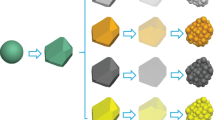Abstract
Deep geothermal energy is typically stored in granite reservoirs, and natural granite is highly heterogeneous because it is composed of different sizes and shapes of mineral grains. The mechanical properties of granite are significantly affected by its heterogeneity, and this may affect the fracture initiation pressure and fracture propagation direction during deep geothermal hydraulic fracturing. An extremely important aspect in examining rock heterogeneity corresponds to the relationship between its macromechanical properties and spatial arrangement of its mineral grains. In this study, a flat-joint model (FJM) in a three-dimensional particle flow code is used to examine the effect of heterogeneity [which is associated with the particle size distribution (PSD)] on the macromechanical properties of granite. Macromechanical properties of numerical models are calibrated via laboratory uniaxial compression tests and Brazilian tension tests. The results indicate that the microparameters of the FJM significantly influence rock mechanical properties, and the relationship between the microparameters and macromechanical parameters is affected by PSD.

Modified from Potyondy (2012)

Modified from Potyondy (2012)











Similar content being viewed by others
References
Cho N, Martin CD, Sego DC (2007) A clumped particle model for rock. Int J Rock Mech Min Sci 44(7):997–1010
Ding X, Zhang L (2011) Simulation of rock fracturing using particle flow modeling: phase I—model development and calibration. In: 45th US rock mechanics/geomechanics symposium. American Rock Mechanics Association
Ding X, Zhang L (2014) A new contact model to improve the simulated ratio of unconfined compressive strength to tensile strength in bonded particle models. Int J Rock Mech Min Sci 69(3):111–119
Ding X, Zhang L, Zhu H, Zhang Q (2014) Effect of model scale and particle size distribution on PFC3D simulation results. Rock Mech Rock Eng 47(6):2139–2156
Fujii Y, Takemura T, Takahashi M, Lin W (2007) Surface features of uniaxial tensile fractures and their relation to rock anisotropy in Inada granite. Int J Rock Mech Min Sci 44(1):98–107
Hoek E, Brown ET (1982) Empirical strength criterion for rock masses. J Geotech Eng Div 106(15715):1013–1035
Ishida T, Chen Q, Mizuta Y, Roegiers JC (2004) Influence of fluid viscosity on the hydraulic fracturing mechanism. J Energy Res Technol 126(3):190–200
Kumari WGP, Ranjith PG, Perera MSA, Shao S, Chen BK (2017) Mechanical behaviour of Australian Strathbogie granite under in situ stress and temperature conditions: an application to geothermal energy extraction. Geothermics 65:44–59
Lan H, Martin CD, Hu B (2010) Effect of heterogeneity of brittle rock on micromechanical extensile behavior during compression loading. J Geophys Res Solid Earth 115(B1):414–431
Lin C, He J, Li X, Wang X, Zhang B (2017) An experimental investigation into the effects of the anisotropy of shale on hydraulic fracture propagation. Rock Mech Rock Eng 50:543–554
Mahabadi OK, Tatone B, Grasselli G (2015) Influence of microscale heterogeneity and microstructure on the tensile behavior of crystalline rocks. J Geophys Res Solid Earth 119(7):5324–5341
Martini CD, Read RS, Martino JB (1997) Observations of brittle failure around a circular test tunnel. Int J Rock Mech Min Sci 34(7):1065–1073
Peng J, Wong LNY, Teh CI (2017) Influence of grain size heterogeneity on strength and microcracking behavior of crystalline rocks. J Geophys Res Solid Earth 122:1054–1073
Potyondy DO (2010) A grain-based model for rock: approaching the true microstructure. In: Proceedings of rock mechanics in the Nordic countries, pp 225–234
Potyondy DO (2012) A flat-jointed bonded-particle material for hard rock. In: 46th US rock mechanics/geomechanics symposium. American Rock Mechanics Association
Potyondy DO, Cundall PA (2004) A bonded-particle model for rock. Int J Rock Mech Min Sci 41(8):1329–1364
Pruess K (2006) Enhanced geothermal systems (EGS) using CO2 as working fluid—a novel approach for generating renewable energy with simultaneous sequestration of carbon. Geothermics 35(4):351–367
Scholtès L, Donzé FV (2013) A DEM model for soft and hard rocks: role of grain interlocking on strength. J Mech Phys Solids 61(2):352–369
Schöpfer MPJ, Abe S, Childs C, Walsh JJ (2009) The impact of porosity and crack density on the elasticity, strength and friction of cohesive granular materials: insights from DEM modelling. Int J Rock Mech Min Sci 46(2):250–261
Vallejos JA, Salinas JM, Delonca A, Ivars DM (2016) Calibration and verification of two bonded-particle models for simulation of intact rock behavior. Int J Geomech 17(4):06016030
Wu S, Xu X (2016) A study of three intrinsic problems of the classic discrete element method using flat-joint model. Rock Mech Rock Eng 49(5):1813–1830
Xu X, Wu S, Gao Y, Xu M (2016) Effects of micro-structure and micro-parameters on Brazilian tensile strength using flat-joint model. Rock Mech Rock Eng 49(9):3575–3595
Acknowledgements
This research was funded by the National Natural Science Foundation of China (no. 41702387), China Postdoctoral Science Foundation (nos. 2017M610507 and 2018T110845), and Open Research Fund Program of Key Laboratory of Deep Geodrilling Technology, Ministry of Land and Resources (no. K201701).
Author information
Authors and Affiliations
Corresponding author
Rights and permissions
About this article
Cite this article
Shu, B., Liang, M., Zhang, S. et al. Numerical Modeling of the Relationship Between Mechanical Properties of Granite and Microparameters of the Flat-Joint Model Considering Particle Size Distribution. Math Geosci 51, 319–336 (2019). https://doi.org/10.1007/s11004-018-09780-7
Received:
Accepted:
Published:
Issue Date:
DOI: https://doi.org/10.1007/s11004-018-09780-7




